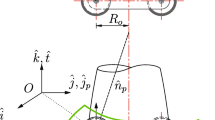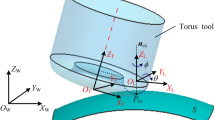Abstract
Within the framework of a study carried out in cooperation with the Sapex Company, we sought to develop an overall machining program for free-form surfaces on a 5-axis NC machine tool. This program comprises a certain number of general cases that will then have to be adapted to specific situations. In this paper, we present the algorithms allowing the following cases to be dealt with:
Positioning a torus mill at a given point on the surface with automatic search for interference between the end of the tool and the surface.
Angular correction or the raising of the tool to avoid interference.
Calculation of trajectories for a “rolling” torus mill on a ruled surface resting on a free-form surface of the NURBS (Non Uniform Rational B-Splines) type.
The latter can be broken down into two parts:
Seeking the axis position on the adjusted surface.
Determination of the tool's point of contact on the freeform surface.
Similar content being viewed by others
References
I. D. Faux and M. J. Pratt, “Computational geometry for design and manufacture”, Ellis Horwood Ltd, 1985.
W. Rubio, “Generation de trajectoires du centre de l'outil pour l'usinage de surfaces complexes sur machines à trois et cinq axes” (Generation of cutter contact trajectories for machining of complex surfaces on three- and five-axis machines). Thesis presented at Université de Toulouse, France 1993.
A. Hansen and F. Arbab, “Fixed axis tool positioning with built-in global interference checking for NC path generation”,IEEE Journal Robotics and Automation, 4(6), pp. 610–621.
S. Li and R. Jerard, “5 axis machining of sculptured surfaces with a flat end cutter”,Computer Aided Design, 26(3), pp. 165–178.
C. Zhu, “Avoiding interference in manufacturing a free form surface with a cylindrical end milling cutter”,Computers in Industry 14, pp. 367–371, 1990.
B. K. Choi and C. S. Jun, “Ball end cutter interference avoidance in NC machining of sculptured surfaces”,Computer Aided Design 21, pp. 371–378, 1989.
R. E. Barnhill and S. N. Kersey, “A marching method for parametric surface/surface intersection”,Computer Aided Geometric Design 7, pp. 257–280, 1990.
J. J. Chen and T. M. Oszoy, “Predictor-corrector type of intersection algorithm for C2 parametric surfaces”,Computer Aided Design 20(6), pp. 347–352, 1988.
B. H. Kim and C. N. Chu, “Effect of cutter mark on surface roughness and scallop height in sculptured surface machining”,Computer Aided Design, 26(3), pp. 179–188.
G. W. Vickers and K. W. Guan, “Ball end-mills for curved surface machining”,Transactions ASME, 111.
K. Marciniak,Geometric Modelling for Numerically Controlled Machining, Oxford University Press, 1991.
Author information
Authors and Affiliations
Rights and permissions
About this article
Cite this article
Rubio, W., Lagarrigue, P., Dessein, G. et al. Calculation of tool paths for a torus mill on free-form surfaces on five-axis machines with detection and elimination of interference. Int J Adv Manuf Technol 14, 13–20 (1998). https://doi.org/10.1007/BF01179412
Issue Date:
DOI: https://doi.org/10.1007/BF01179412




